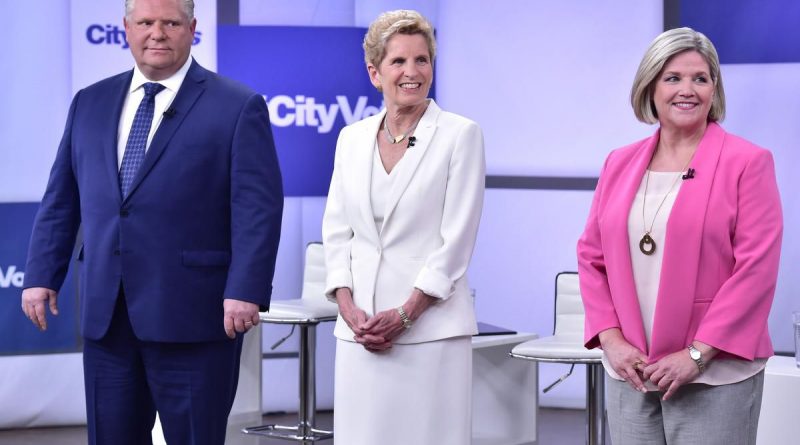A Province Divided: Ontario’s Provincial Election
Progressive Conservatives emerge victorious while Liberals lose party status
Key Actors:
- Doug Ford – Leader of the centre-right Ontario Progressive Conservative Party
- Andrea Horwath – Leader of the left-wing Ontario NDP
- Kathleen Wynne – Incumbent Premier of Ontario, leader of the Ontario Liberal Party
In a sweeping victory on June 7th, the Doug Ford’s Ontario Progressive Conservative Party won a majority of seats in Ontario’s Provincial election. This event ends fifteen years of Liberal rule in the province under various premiers, the latest being Kathleen Wynne.
The Progressive Conservatives won 76 seats in Ontario’s 124-seat Provincial Parliament, while the NDP won 40. Most surprisingly, however, the Liberal Party took a stunning loss with only seven seats, meaning that they lose status as an official party. Under Ontario election law, a party must have at least eight seats to be recognized as an official political party, marking a severe humiliation for the Liberals who have held power for the last fifteen years.
Events Leading to the Election
In the months leading up to the election, the NDP and the Progressive Conservatives were evenly matched in terms of popular support, with the Liberals trailing far behind. After over a decade of Liberal rule and poor management, such as high electric prices after the sale of Ontario’s electric company Hydro One, public opinion was against the Liberals.
In an unprecedented statement by Liberal leader Kathleen Wynne a week before the election, she even acknowledged that her party would not retain premiership. Thus, the two alternatives for Ontarians remained Doug Ford’s Progressive Conservatives and Andrea Horwath’s NDP.
The Progressive Conservative Party
A prominent businessman and politician, Doug Ford was chosen as leader of the Progressive Conservative Party in March after the previous leader Patrick Brown stepped down due to allegations of sexual misconduct.
In the typical conservative manner, Ford’s policies mainly involve reducing government spending, lowering tax rates, and opposing a Federal carbon tax. A few promises involved more spending, such as lowering fuel and electricity prices. However, critics were quick to point out that Ford’s platform failed to detail how the costs would be covered while also lowering taxes.
The NDP
Andrea Horwath has been the leader of the provincial NDP for the previous nine years and three elections. In this election, her policies mainly focus on raising taxes on businesses and the highest earners, returning Ontario’s electric company Hydro One to public hands, and expanding Ontario’s transit services.
The Liberal Party
The Liberal Party struggled and failed to keep their status as an official party in Ontario’s Provincial Parliament. Without this, their government-provided funding will be removed. They will no longer be guaranteed the right to question other parties in Parliament. With such an election result, the Liberals may find it hard to acquire the funds and public image to rebuild their party in time for the next election.
The Future
With a Progressive Conservative majority government, Ontario will like experience sweeping changes in the near future. Their vague budget plan leaves many questioning whether the Progressive Conservatives can actually fulfill many of their promises. For some, this signals a period of doubt and uncertainty. For others, Ford’s election marks a beginning of a new Ontario freshly released from Liberal rule. We’ll soon know how the new Progressive Conservative government fares through its four-year tenure.
Statistics
- NDP want to raise Corporate Tax to 13%, Liberals want to keep it at 11.5%, and the Progressive Conservatives want to lower it to 10.5%
- 58% voter turnout, up 7% from last election
- Progressive Conservatives received 40% of the popular vote, but 61% (76) of the seats
- NDP received 34% of the popular vote, but 32% (40) of the seats
- Liberals received 20% of the popular vote, but 6% (7) of the seats
- Greens received 5% of the popular vote, but 0.8% (1) of the seats
Bibliography
Canadian Press. Liberal Premier Kathleen Wynne admits she won’t win provincial election | Toronto Sun. 2 June 2018. 7 June 2018. <http://torontosun.com/news/provincial/liberal-premier-kathleen-wynne-admits-she-wont-win-provincial-election>.
Elections Ontario. Elections Ontario Provincial Results. 07 June 2018. 08 June 2018. <https://www4.elections.on.ca/RealTimeResults/Province>.
McArthur, Donald and Dalson: Campbell, Taylor Chen. 2018 Ontario election | Windsor Star. 8 June 2018. 8 June 2018. <http://windsorstar.com/news/local-news/2018-ontario-election-live>.
Scotti, Monique. From sex-ed to a carbon tax: Here’s where Doug Ford stands on big issues | Globalnews.ca. 12 March 2018. 8 June 2018. <From sex-ed to a carbon tax: Here’s where Doug Ford stands on big issues>.
The Globe and Mail. Ontario election guide: What you need to know before you vote – The Globe and Mail. 7 June 2018. 8 June 2018. <https://www.theglobeandmail.com/canada/article-ontario-election-guide/>.
Vomiero, Jessica. Kathleen Wynne won her seat, but the Liberals lost official party status | Globalnews.ca. 7 June 2018. 8 June 2018. <https://globalnews.ca/news/4261192/kathleen-wynne-liberal-official-party-status/>.
https://news.ontario.ca/opo/en/2013/10/ontario-launches-open-government.html

